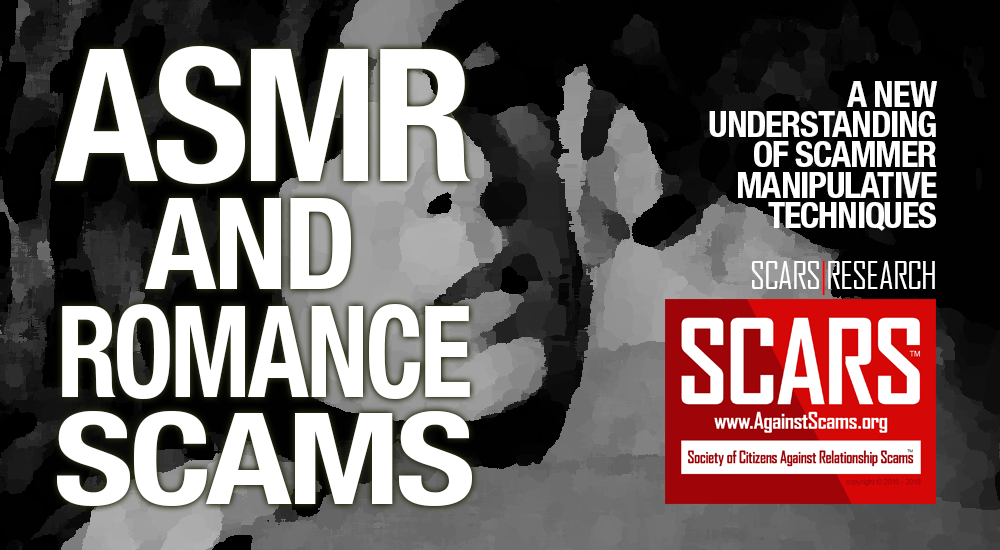SCARS™ Psychology of Scams: ASMR – Using Your Brain & Body Against You
The Following Is An Summarization & Analysis Of A Scammer Manipulative Technique From SCARS|RESEARCH
We encourage you to explore this topic futher.
Introduction
In the exploration for the psychological triggers and controls of the Romance Scam phenomena, we have looked at and discussed several different ways that scammers manipulate and control their victims.
These included triggering something called an Amygdala Hijack », where stimulus triggers a deep emotional response and floods the brain with the corresponding hormones, scam bonding », and Gaslighting », as well as others » We encourage you to read the articles relating to the Psychology of Scams » to better understand them and how scammers gain control in the fake relationships that resulted in your scam and trauma.
However, we have also become aware of and come to believe that there is another unique trigger that is being employed by the scammers in their grooming and control processes of victims that until very recently was little understood.
In this article, we are going to explain what ASMR is and how it works so you will have a background to understand how we theorize its function and effect in Romance Scams.
THIS IS CALLED “ASMR”
What is ASMR?
ASMR is the term for a sensation people get when they watch stimulating videos or take part in other activities — usually ones that involve personal attention. Many people describe the feeling as “tingles” that run through the back of someone’s head and spine. Others say the feeling is deeply relaxing, and can even cause them to fall asleep.
However, it is also triggered by sounds and even by someone speaking softly. It can even be triggered by attention focused on the recipient.
But wait, the importance of this is coming …
To Be More Technical:
ASMR is “Autonomous Sensory Meridian Response” (commonly referred as ASMR) and is an experience characterized by a static-like or tingling sensation on the skin that typically begins on the scalp and moves down the back of the neck and upper spine, but it can spontaneously start on the arms or legs or middle of the back. It has been compared with auditory-tactile synesthesia » and may overlap with frisson »
ASMR is a subjective experience of “low-grade euphoria” characterized by “a combination of positive feelings and a distinct static-like tingling sensation on the skin.” It is most commonly triggered by specific auditory or visual stimuli, but can also be triggered by intentional attention control.
General Introduction To ASMR Video
The following video completely introduces the ASMR concepts and how it functions in a generalize and very entertaining way, though it does not get into the darker side of how it can be used! We encourage you to watch it to the end!
While the video may show the fun and relaxing aspect of ASMR there is also a dark side.
The Sensation
The subjective experience, sensation, and perceptual phenomenon now widely identified by the term “Autonomous Sensory Meridian Response” are described by some of those susceptible to it as “akin to a mild electrical current…or the carbonated bubbles in a glass of champagne.”
ASMR Is Usually Precipitated By Stimuli Referred To As “Triggers.”
ASMR triggers, which are most commonly auditory and visual, may be encountered through the interpersonal interactions of daily life.
Additionally, ASMR is often triggered by exposure to specific audio and video. Such media may be specially made with the specific purpose of triggering ASMR or originally created for other purposes and later discovered to be effective as a trigger of the experience.
Thus it can be triggered by the sound of a person’s voice, what they say and how they say it. It might even be triggered by something you read (see).
ASMR Stimuli
Stimuli that can trigger ASMR, as reported by those who experience it, include the following:
- Listening to a softly spoken or whispering voice
- Listening to quiet, repetitive sounds resulting from someone engaging in a mundane task such as turning the pages of a book
- Receiving tender personal attention
- Initiating the stimulus through conscious self-manipulation without the need for external video or audio triggers – such as thinking about someone
- Listening to repetitive tapping sounds typically nails onto surfaces such as plastic, wood, metal, etc. – or rain or breathing
- Hand movements with a tactile experience, especially onto one’s face – though it can be perceived and not felt
- Watching and listening to an audiovisual recording of a person performing or simulating the above actions and producing their consequent and accompanying sounds is sufficient to trigger ASMR for the majority of those who report susceptibility to the experience
The result of these Stimuli is that they can induce relaxation, but also place a person into a more suggestive and trustful state.
ASMR TRIGGERS
Whispering Triggers
Psychologists Nick Davis and Emma Barratt discovered that whispering was an effective trigger for 75% of the 475 subjects who took part in an experiment to investigate the nature of ASMR » and that statistic is reflected in the popularity of intentional ASMR videos that comprise someone speaking in a whispered voice. [Watch the video above]
Auditory Triggers
Many of those who experience ASMR report that some specific non-vocal ambient noises are also effective triggers of ASMR, including those like the sound of rain, fingers scratching or tapping a surface, the crushing of eggshells, the crinkling and crumpling of a flexible material such as paper, or writing. Many YouTube videos that are intended to trigger ASMR responses capture a single person performing these actions and the sounds that result. We suggest that you look up “ASMR” in YouTube for yourself.
Personal Attention Role Triggers
In addition to the effectiveness of specific auditory stimuli, many subjects report that ASMR is triggered by the receipt of tender personal attention, often comprising combined physical touch and vocal expression, such as when having their hair cut, nails painted, ears cleaned, or back massaged, whilst the service provider speaks quietly to the recipient. Furthermore, many of those who have experienced ASMR during these and other comparable encounters with a service provider report that watching an “ASMRtist” simulate the provision of such personal attention, acting directly to the camera as if the viewer were the recipient of a simulated service, is sufficient to trigger it.
Psychologists Nick Davis and Emma Barratt discovered that personal attention was an effective trigger for 69% of the 475 subjects who participated in a study conducted at Swansea University, second in popularity only to whispering.
Some roleplays also incorporate fantasy or science fiction elements in a way that allows “escape” for the viewers. Some also incorporate legitimate stories into the roleplays in a way that could be considered entertainment in its own right, outside of the ASMR phenomenon.
This is where the romance scammer can use ASMR to induce effects that further enable their manipulative goals.
Clinical Role Play Triggers
Among the category of intentional ASMR videos that simulate the provision of personal attention is a subcategory of those specifically depicting the “ASMRtist” providing clinical or medical services, including routine general medical examinations. The creators of these videos make no claims to the reality of what is depicted, and the viewer is intended to be aware that they are watching and listening to a simulation, performed by an actor. Nonetheless, many subjects attribute therapeutic outcomes to these and other categories of intentional ASMR videos, and there are voluminous anecdotal reports of their effectiveness in inducing sleep for those susceptible to insomnia, and assuaging a range of symptoms including those associated with depression, anxiety, and panic attacks.
These demonstrate the ability to manipular the viewer using the ASMR approach.
“The ‘ASMR effect’ is clearly strongly related to the perception of non-threat and altruistic attention and has a strong similarity to physical grooming in primates who derive enormous pleasure (bordering on euphoria) when being groomed by a grooming partner…not to get clean, but rather to bond with each other.”
Association With Sexuality
People who experience ASMR report feeling relaxed and sleepy after watching and listening to ASMR content. While some journalists and commentators have portrayed ASMR as intimate, they go on to say there is no evidence of any connection between ASMR and sexual arousal.
However, these effects can play a strong role in preparing the type of anticipation that allows for easier setup or grooming by a scammer.
IN ROMANCE SCAMS
This is where we now head into uncharted territory, the potential or real dark side of ASMR.
Preparing For The Scam (Grooming) And The Maintenance Of Control
First, let’s look at what are the reported effects of ASMR on subjects:
- Relaxation
- Euphoria
What do these things have to do with scams? They kill suspicion and distrust. By placing the victim into a relaxed euphoric state that can effectively open them to other forms of suggestion and manipulation far more easily than without.
Thus our theory is that the use of ASMR technique will allow the victim to be more easily triggered into Amygdala Hijack and that the continued use can more profoundly cement the bond between the scammer and the victim, allowing more tightly controlled manipulation over time.
We are not suggesting that scammers are expertly trained all of these manipulative effects and techniques, some clearly are. It is more a case that they are employing natural approaches and “romantic” technics of seduction that also coincide with these processes. Many people have a natural intuition for how to seduce members of the opposite sex without really understanding how they do, this is we believe also the case in most scammers.
Use As A Deflector
We have heard from victims that when they become anxious or are beginning to have doubts in their scammers or in what they are being sold, that such “vocal” approaches seemed to calm them down and reduce suspicion.
These could be any number of techniques, but we have heard from many that after they learned about the ASMR approaches, having seen them in videos, they reported that some scammers changed the tone and volume of their voices and they also hear other sounds such as finger tapping.
SUMMARY
We know that there are vast amounts of discussion about the ASMR effect and its role in relaxation. Ironically this may also be a perfect technique to help scam victims find relaxation and ways to overcome anxiety following their scam. SCARS will explore this in our scam victim’s support groups and we encourage you to learn more about it for your own benefit.
However, there appears to be evidence that romance scammers and perhaps scammers in other verticals are employing these techniques as a way of overcoming specific barriers and reducing stress and suspicion in victims. Until there is academic research we cannot say with certainty what brain functions are being affected.
In most things, awareness of a technique is sufficient to overcome it. In this case, our hope is that scam victims can explore their personal experiences to look for places where these ASMR techniques may have been used and in so knowing may prevent themselves from being manipulated in this way in the future. Additionally, we hope that ASMR can also be used as a self-help therapy for scam victim recovery and in the process further enlighten victims about it and enhance their control when they want to submit to it for their use.

SCARS™ Team
A SCARS Division
Miami Florida U.S.A.
TAGS: ASMR, Autonomous Sensory Meridian Response, Scam Response Trigger, SRT, ASMR TRIGGERS, Stimuli, ASMRtist, Psychology of Scams, Manipulation, Control,
END
– – –
Tell us about your experiences with Romance Scammers in our Scams Discussion Forum on Facebook »
– – –
FAQ: How Do You Properly Report Scammers?
It is essential that law enforcement knows about scams & scammers, even though there is nothing (in most cases) that they can do.
Always report scams involving money lost or where you received money to:
- Local Police – ask them to take an “informational” police report – say you need it for your insurance
- Your National Police or FBI (www.IC3.gov »)
- The SCARS|CDN™ Cybercriminal Data Network – Worldwide Reporting Network HERE » or on www.Anyscam.com »
This helps your government understand the problem, and allows law enforcement to add scammers on watch lists worldwide.
– – –
Visit our NEW Main SCARS Facebook page for much more information about scams and online crime: www.facebook.com/SCARS.News.And.Information »
To learn more about SCARS visit www.AgainstScams.org
Please be sure to report all scammers HERE » or on www.Anyscam.com »
All original content is Copyright © 1991 – 2020 SCARS All Rights Reserved Worldwide & Webwide – SCARS/Romance Scams Now & SCARS/Society of Citizens Against Relationship Scams are all trademarks of Society of Citizens Against Relationship Scams Incorporated (formerly the Society of Citizens Against Romance Scams)
Legal Notices:
All original content is Copyright © 1991 – 2020 SCARS All Rights Reserved Worldwide & Webwide. Third-party copyrights acknowledge.
SCARS, RSN, Romance Scams Now, SCARS|WORLDWIDE, SCARS|GLOBAL, SCARS, Society of Citizens Against Relationship Scams, Society of Citizens Against Romance Scams, SCARS|ANYSCAM, Project Anyscam, Anyscam, SCARS|GOFCH, GOFCH, SCARS|CHINA, SCARS|CDN, SCARS|UK, SCARS Cybercriminal Data Network, Cobalt Alert, Scam Victims Support Group, are all trademarks of Society of Citizens Against Relationship Scams Incorporated.
Contact the law firm for the Society of Citizens Against Relationship Scams Incorporated by email at legal@AgainstScams.org





Please Leave A Comment - Tell Us What You Think About This!